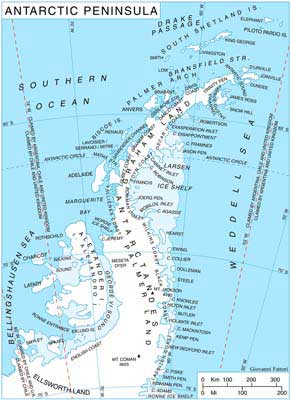Peninsula Luis Felipe, Antarctica
María Angélica Godoi and Marcelo Arevalo,
Universidad de Magallanes (UMAG) and
Fundación Centro de Estudios del Cuaternario (CEQUA),
Ricardo Jaña
Instituto Antárctico Chileno (INACH) and CEQUA
January 26, 2007 to February 20, 2007
Updates: 10 February
 Climate models suggest that the Antarctic and Southern Ocean will, like the Arctic, be severely impacted by greenhouse gas warming. The Southern Ocean and most of the Antarctic continent are expected and appear to be slower to respond. However, the far most dramatic responses will occur in northern portions of the Antarctic Peninsula – a region between interior East Antarctica and Tierra del Fuego. The impact of accelerated climate change over the Antarctic and Southern Ocean is not yet fully known, nor is the natural baseline from which to understand present and future change. In this context, palaeoclimatic information still preserved in the most sensitive regions should be promptly recovered and for that end, ice cores provide the most robust reconstruction of past climate (temperature, precipitation, atmospheric circulation, chemistry of the atmosphere).
Climate models suggest that the Antarctic and Southern Ocean will, like the Arctic, be severely impacted by greenhouse gas warming. The Southern Ocean and most of the Antarctic continent are expected and appear to be slower to respond. However, the far most dramatic responses will occur in northern portions of the Antarctic Peninsula – a region between interior East Antarctica and Tierra del Fuego. The impact of accelerated climate change over the Antarctic and Southern Ocean is not yet fully known, nor is the natural baseline from which to understand present and future change. In this context, palaeoclimatic information still preserved in the most sensitive regions should be promptly recovered and for that end, ice cores provide the most robust reconstruction of past climate (temperature, precipitation, atmospheric circulation, chemistry of the atmosphere).
Researchers from UMAG and CEQUA have join with researchers from the Climate Change Institute, University of Maine (USA), to find suitable sites for recovery of well–preserved environmental signals in ice cores from the northern reaches of the Antarctic Peninsula and the sub–Antarctic regions. In this project we propose to investigate the potential of the ice cap covering the Península Luis Felipe, in the northernmost part of the Antarctic Peninsula, as a palaeoclimatic archive. The main aim is to study the feasibility for the future retrieval of high resolution, sub–annually–resolved, multi-parameter ice cores to bedrock that will yield climate records (temperature, precipitation, atmospheric circulation, chemistry of the atmosphere) covering the last several centuries and possibly millennia.
